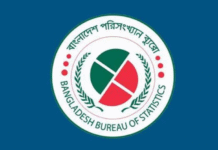The lender now says Bangladesh’s GDP growth will fall to 5.8pc this year on slow exports, investment
The World Bank has revised down its GDP growth forecast for Bangladesh to 5.8 percent due to slow exports and low investment.
The global lender earlier projected the country’s GDP (gross domestic product) growth at around 6 percent, while the last year’s growth was 6.3 percent.
The lender yesterday released Global Economic Prospectus Report, which said the fall in growth will be partly due to moderation in exports, resulting from an adverse global environment.
“Weak exports are underpinned by Euro area crisis and fiscal policy uncertainties in a slowly recovering US economy,” WB senior economist Zahid Hussain told The Daily Star.
Bangladesh’s compliance related image problems and trade logistics constraints are also affecting exports, he added.
He said private investment also appears to be still stagnating due to insufficient improvements in infrastructure, particularly roads; continuing gas shortages, and political uncertainties in the run up to national elections.
The WB report said, although export performance weakened in 2012, domestic demand was supported by steady inflows of remittances and a relatively stable farm sector.
The report also said external constraints have been exacerbated by supply side bottlenecks, including inadequate infrastructure, and by political uncertainty.
The WB said a further diversification of export markets and gains in market share will benefit Bangladesh, as growth is expected to pick up faster in North America and Asia compared with the near-stagnant Euro area in 2013.
“Infrastructure and energy constraints could, however, slow further gains in competitiveness.”
Bangladesh’s GDP growth is forecast to rise to 6.2 percent in fiscal 2013-14, as the global economy continues its slow path to a recovery, the WB said.
The growth will pick up to 6.5 percent in 2014-15, it said.
However, South Asia’s GDP growth is projected to rise to 5.7 percent in the 2013 calendar year from 5.4 percent in 2012, the WB report said.
The report said the modest recovery in the growth is in line with projections of a weak global economy and near-stagnant output in the Eurozone, South Asia’s largest trade partner.
It also said regional growth will be constrained by an uncertain external environment amid risks of a protracted fiscal impasse in the US and possible resurgence of Eurozone turmoil.
The report said electricity shortages are expected to ease gradually over time as South Asian countries continue structural reforms to expand capacity and improve financial sustainability of the sector.
A fall in oil prices due to weaker than projected global growth would benefit current account position of the South Asian countries, including Bangladesh, and reduce the fiscal burden of fuel subsidies.
But lower oil prices would also cut into migrant remittances if economic activity in the migrant destinations in the oil-exporting Gulf region were to slow and demand for migrant labour were to decline.
On the global economic scenario, the report said, four years after the onset of the global crisis, the world economy remains fragile and growth in high-income countries is week.
The developing countries need to focus on raising the growth potential of their economies.
World Bank Group President Jim Yong Kim said, “Developing countries have remained remarkably resilient thus far. But we can’t wait for a return to growth in the high-income countries.”
“So we have to continue to support developing countries in making investments in infrastructure, in health, in education. This will set the stage for the stronger growth.”
The WB estimates global GDP grew 2.3 percent in 2012, compared with last June’s expectation of 2.5 percent. Growth is expected to remain broadly unchanged at 2.4 percent in 2013, before gradually strengthening to 3.1 percent in 2014 and 3.3 percent in 2015, it said.
Source: The Daily Star










